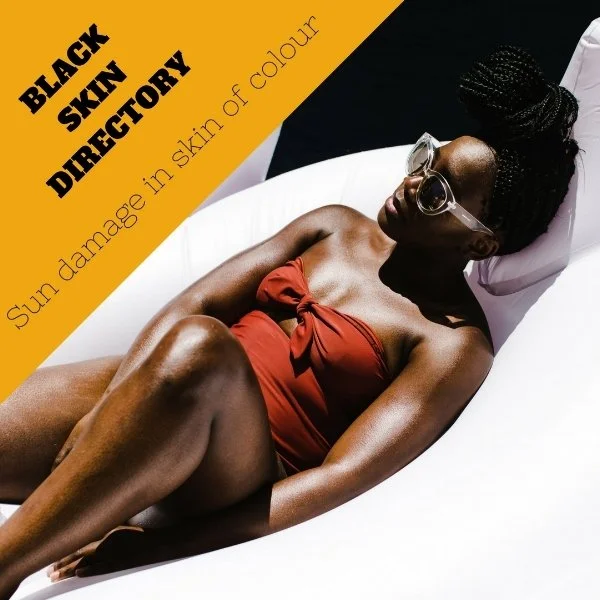Sun Damage in Skin of Colour
CONTRARY TO POPULAR BELIEF, BLACK SKIN DOES CRACK AND SUFFERS THE UNDESIRABLE EFFECTS OF SUN DAMAGE. IN THIS ARTICLE, I WILL EXPLAIN HOW THIS DAMAGE LOOKS ON BLACK SKIN AND HOW IT CAN BE PREVENTED.
UVA and UVB rays create inflammation in the skin, which results in changes to skin cells and melanin pigmentation in the skin.
During prolonged sun exposure the top most layer of the epidermis thickens as the sun triggers increased replication of skin cells as well as an increase in the production of melanin.
The increase of melanin in what is typically referred to as a tan, however it is in fact immense DNA damage resulting in the increased darkening of existing pigmentation and/or the formation of pigmentation in new areas which gives the skin an uneven, patchy appearance.
As we enjoy sunnier days it is important to be able to identify the signs of sun damage and better yet, take sensible preventative measures.
Physical manifestations of sun damage can result in the development and/or exacerbation of the following conditions that are found in skin of colour:
“Black does crack!”
— Black Skin Directory Professionals
MELASMA
Melasma is a form of diffused hyperpigmentation that occurs as a symmetrical over production of melanin and is usually visible over the face - cheeks, forehead, upper lip, nose and chin.
Melasma appears as tan-brown patches, which gradually grow over time.
POST-INFLAMMATORY HYPERPIGMENTATION
Post-inflammatory hyperpigmentation (PIH) is an equally common pigmentation disorder that affects most skin types but it occurs more frequently in skin of colour. PIH develops after the skin experiences an injury or inflammation of any type including sun damage.
SOLAR LENTIGINES
Solar lentigines are usually referred to as dark spots, age or liver spots. They are small, superficial pale to dark brown patches of hyperpigmentation and occur on exposed parts of the body – most commonly on the hands, face and décolletage. They vary in size and number and tend to increase with age.
DERMATOSIS PAPULOSA NIGRA (DPN)
Dermatosis papulosa nigra (DPN) is a chronic skin condition characterized by small, benign, hyperpigmented lesions on the cheeks, forehead, neck, upper back, and chest. They are smooth, firm and black or dark-brown in colour. The lesions often increase with age and are common in women with black skin.
POIKILODERMA OF CIVATTE
This skin condition appears as brownish patches seen mainly on the sides of the neck, upper chest and sides of cheeks. It is common in women of colour, especially those who are fair-skinned and sun exposure is one of the predisposing factors amongst hormonal changes, genetics and sensitizing cosmetic ingredients like perfume.
COLLAGEN DEPLETION & SOLAR ELASTOSIS
Collagen depletion is an important factor in skin ageing. Although skin of colour and black skin especially has a thicker dermis and more collagen, it is not exempt from photoageing (premature aging of the skin caused by repeated exposure to UV radiation). Black does crack, I’m afraid!
Over time, UV rays stimulate a reaction that results in the depletion of collagen, the shutdown of new collagen production and accumulation of ineffective elastin. The accumulation of this non-functional elastin is known as solar elastosis and where skin is dry and wrinkled with a loss of tone and uneven pigmentation.
How can sun damage be treated?
Firstly, prevention is always best. Using a broad-spectrum UVA/UVB sunscreen with a minimum SPF 30 is extremely important. Additionally wearing brimmed hats, appropriate clothing and using an umbrella provide additional effective protection.
Check out our chic sunny day choices for inspiration.
Secondly, there are extremely sophisticated first line treatments including the use of topical ingredients such as hydroquinone, mequinol (both requiring medical prescription and supervision) liquorice extract, kojic acid, azelaic acid, arbutin, retinoids, ascorbic acid (vitamin C), niacinamide and n-acetylglucosamine,.
Chemical peels; laser and dermabrasion also remain popular options amongst the Black Skin Directory professional community.

